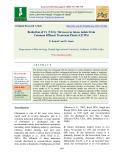Int.J.Curr.Microbiol.App.Sci (2018) 7(7): 693-710
International Journal of Current Microbiology and Applied Sciences ISSN: 2319-7706 Volume 7 Number 07 (2018) Journal homepage: http://www.ijcmas.com
https://doi.org/10.20546/ijcmas.2018.707.084
Original Research Article
Reduction of Cr (VI) by Micrococcus luteus isolate from Common Effluent Treatment Plants (CETPs) P. Katyal* and G. Kaur Department of Microbiology, Punjab Agricultural University, Ludhiana-141004, India *Corresponding author
A B S T R A C T
The present study was envisaged with the objective to isolate indigenous chromate tolerant bacteria from effluents and their subsequent utilization for chromium uptake or reduction. Samples were collected from two different Common Effluent Treatment Plants (CETPs), located in Ludhiana (sample 1) and Jalandhar (sample 2). In both the samples, chromium was found to be the dominant metal contaminant. A total of 10 morphologically distinct isolates were tested for their tolerance to chromium in terms of minimum inhibitory concentration (MIC) of Cr required for complete inhibition of growth. Four isolates (HM 2, HM 3, HM 15 and HM 16) showed maximum tolerance to chromium. There was no active uptake of Cr in sample 1 but considerable uptake was observed in sample 2. Chromium reduction efficiency was determined by S-diphenyl-carbazide (DPC) method, whereby complete reduction was observed with the standard culture (Shewanella putrefaciens) followed by 76.66% by HM 16 and 46.76% by HM 2 after 7 hours of incubation. Molecular characterization of most potent isolate (HM 16) was carried out using 16S rDNA based molecular method.
K e y w o r d s Bioremediation, CETPs, DPC, Cr (VI) reduction, 16S rDNA sequencing Article Info Accepted: 06 June 2018 Available Online: 10 July 2018
chromium is discharged into
leather
these
(Dermou et al., 2005; Boyd 2010, Singh and Prasad 2015). Safe value in water for drinking purposes is 0.05 mg/L and recommended value for discharge is less than 5 mg/L (Directive EPA, USA, 2003; Debabrata et al., 2006). In nature, chromium mainly exists in two forms, hexavalent Cr (VI) and trivalent Cr (III) form. In the industrial wastes it is primarily present in the hexavalent form as 2-) and divalent oxyanions, chromate (CrO4 2-). It is an essential trace dichromate (Cr2O7 metal, but overexposure to Cr (VI) produces
Introduction Chromium is one of the most toxic heavy metal used in several industries and is a common industrial pollutant. A large quantity of the environment mainly from industrial operations including metal finishing industry, petroleum refinery, iron and steel tanning, industries and causes a serious threat to human health (Oladipo et al., 2014; Dixit et al., industries 2015). The effluents of contain chromium at concentrations ranging from tenths to hundreds of milligrams per liter
693
Int.J.Curr.Microbiol.App.Sci (2018) 7(7): 693-710
to the extracellular domain due
through permeability
The by
approach useful for
in
the potential
ulceration in the skin, mucous membranes and nasal septum, allergic dermatitis, renal tubular necrosis and increases risks of respiratory tract-cancer (Lu and Yang 1995; Flavio et al., 2004). The hexavalent chromium compounds are comparatively more toxic than those of Cr (III) due to their higher solubility in water, biological rapid membranes and subsequent interaction with intracellular proteins and nucleic acids (Basu et al., 1997). Hexavalent chromium (Cr (VI)) reduction to trivalent chromium (Cr (III)) could constitute a potential detoxification process that could be achieved via chemical or chemical biological methods. However, reduction requires energy input and large quantities of chemicals and generation of sludge (Srivastava et al., 1986; Hashim et al., 2011; Yao et al., 2012). Biological reduction could, therefore, provide a useful alternative economical process (Congeevaram et al., 2007). which processes microorganisms interact with toxic metals enabling their removal and recovery are bioaccumulation, biosorption and enzymatic reduction (Ohtake and Silver 1994; Srinath et al., 2002). Reduction of Cr (VI) to Cr (III) represents a the potentially detoxification of chromate from wastewater and environment (Marsh and McInerney, 2001; Liu et al., 2012; Shah et al., 2014). Biological Cr (VI) detoxification which is more ecofriendly and an economically feasible technology can be a suitable approach (Wang and Xiao 1995; Mclean and Beveridge 2001; Srinath et al., 2002; Elangovan et al., 2006). However, for biological treatment of Cr (VI)-contaminated waste is limited because some microorganisms lose viability in the presence of high concentrations of chromate. Isolating chromate-reducing from contaminated environments bacteria could therefore be useful (Dmitrenko et al., 2003; Balamurugan et al., 2014, Katyal et al., 2015). In Bacillus sp. ES29 chromate reducing activity was localized in the cell free extract which utilizes NADH as the sole electron donor (Pal et al., 2005). In some cases, the reduction of Cr (VI) was shown to take place in the excretion of metabolites possessing a chemical reducing power. For example, Thiobacillus ferrooxidans was shown to generate sulphite and thiosulfate which reduce Cr (VI) at low pH (Sisti et al., 1996). The Cr (VI) reduction by bacterial cultures (Klaus-Joerger et al., 2001; Francisco et al., 2002; Cheung and Gu 2003; Ilias et al., 2011) has been extensively studied under aerobic and/or anaerobic conditions. This work mainly focuses on the isolation of chromium resistant strains of bacteria for the reduction/uptake of Cr (VI) and their applicability in treatment of metal- rich effluents. Materials and Methods Sample collection and preparation Effluent samples were collected from Punjab Small Industries and Export Cooperation (PSIEC) Leather Complex common effluent treatment plant (CETP), Kapoorthala road, and Ludhiana Electroplaters Jalandhar Association CETP, Focal Point, Ludhiana. Samples were collected in sterile plastic containers the month of September- October, 2015 and were allowed to settle for 2h. After filtration through Whatmann filter No. 1, samples were tested for their pH, Chemical Oxygen Demand (COD), dissolved oxygen (DO), Biological Oxygen Demand (BOD) using standard methods (APHA 2001). Heavy metal profile of effluent The concentration of heavy metals present in both the effluent samples was estimated using Inductively Coupled Argon Plasma-Atomic Emission Spectroscopy (ICAP-AES). One
694
Int.J.Curr.Microbiol.App.Sci (2018) 7(7): 693-710
taken
of standard
samples were g/L,
3:- Effluent
in 250 ml
hundred ml of sample was digested with 5ml of concentrated HNO3 and suitably diluted for heavy metal analysis by iCAP 6300 (Singh et al., 2015). Procurement and maintenance of standard culture The Shewanella culture putrefaciens MTCC 8104 was procured from Institute of Microbial Technology (IMTECH), 39A, Sector 39, Chandigarh, India. It was maintained by periodic sub-culturing on Luria Bertani Agar after every 3 weeks. Isolation and maintenance of bacterial isolates Isolation of indigenous chromium resistant bacteria was carried out using standard microbiological techniques by which Luria Bertani Agar plates supplemented with 5mg/L concentration of Cr was used. Pure cultures of bacterial colonies were preserved at 4°C as slant cultures for further analysis. Determination of Minimum Inhibitory Concentration (MIC) of different selected heavy metals Maximum resistance of the isolates to Cr was evaluated in LB agar plates amended with Cr in concentration ranging from 5ppm to 100ppm. The lowest concentration of heavy metal at which no growth occurred when the control plates was compared with Inhibitory the Minimum considered as Concentration (MIC). Determination of heavy metal uptake by selected isolates To determine the ability of selected isolates for heavy metal uptake, attempt was made to grow both the selected isolates on effluent samples collected from Ludhiana (sample 1) and Jalandhar (sample 2). Two-fifty ml of in 500 ml effluent sample was volumetric flask, autoclaved at 15 lbs for 20 minutes and was inoculated with 0.2 ml of 12 hour old culture of HM 2 and HM 16 individually. Samples were taken to observe the heavy metal profile after 5 days and 10 days of growth. A set of un-inoculated effluent sample was kept as control. Following set of treatments were used: Control:- Effluent samples as such without any modification was used as growth medium for both the selected isolates. 1:- Effluent Treatment supplemented with D-glucose-2.5 MgSO4.7H2O-0.5 g/L and KNO3-0.18 g/L. Treatment 2:- Effluent samples were modified to adjust their pH at 6.0 because at this pH most of the metals exists in their free ion state. samples were Treatment supplemented as in Treatment 1 and their pH was adjusted to 6.0. Growth profile of selected isolates w.r.t standard culture Growth of selected isolates w.r.t standard culture was studied flasks containing 50 ml sterile LB broth. These flasks were inoculated separately with 0.5ml of overnight culture of selected isolates and standard culture and agitated on a rotary shaker at 150 rpm. Growth was monitored by measuring the optical density (O.D) at 600 nm using spectrophotometer at different time interval 0, 1, 2, 3, 4, 5, 6 and 7 h (Camargo et al., 2003). Chromium reduction efficiency of selected isolates and standard culture Selected isolates and the standard culture were grown in 50 ml of LB medium with 20 ppm K2Cr2O7 at 37°C with orbital shaking (150
695
Int.J.Curr.Microbiol.App.Sci (2018) 7(7): 693-710
by using concentration
the different
ice. Cell in
identification of Argon rpm). Samples were withdrawn at 1 h interval and centrifuged at 10,000 rpm for 5 min and the supernatants were assayed for residual Cr (VI) S- diphenylcarbazide (DPC) method (Barlett and James 1996). Hexavalent chromium was determined colorimetrically. Standard curve readings was plotted with obtained by taking absorbance at 540 nm. Determination of site of chromate reductase activity The reaction for the chromate reductase activity contained 20mg/L Cr(VI) as K2Cr2O7 in 0.5 ml of 100 mM phosphate buffer, held at 37°C in a water bath. Bacteria were grown overnight in 100 ml of LB medium with 20 mg/L K2Cr2O7 at 37ºC with orbital shaking (150rpm). Thereafter, cells of each isolate were harvested by centrifugation of 30 ml culture at 5,000 rpm for 10 min. Culture supernatant was collected and the cell pellet was resuspended in 30 ml phosphate buffer (10 mM, pH 7). Cells in an ice bath were disrupted with an ultrasonic probe. Power was applied ten times in 30s pulses with 30s intervals. The sonicate was centrifuged at 16,000 rpm at 4ºC for 20 min. Cell extract supernatant was transferred in a fresh tube and was kept lysate was also resuspended in 30 ml phosphate buffer (Ilias et al., 2011). The reaction was initiated by the addition of 0.5 ml each of culture supernatant, cell extract supernatant and cell lysate and residual Cr (VI) concentration was measured after 1 h following the (DPC) method. One unit of enzyme activity was defined as 1 μmol of Cr (VI) reduced/min/ml at 37°C. Molecular identification of the bacterial isolate by 16S rDNA sequencing Molecular the bacterial isolate was done through outsourcing by Eurofins Genomics India Pvt Ltd. DNA was isolated and its quality was evaluated on 1.0% Agarose Gel, a single band of high-molecular weight DNA has been observed. Fragment of 16S rDNA gene was amplified by 27F and 1492R primers. A single discrete PCR amplicon band of 1500 bp was observed when resolved on Agarose gel. Forward and reverse DNA sequencing reaction of PCR amplicon was carried out with forward primer and reverse primers using BDT v3.1 Cycle sequencing kit on ABI 3730xl Genetic Analyzer. Consensus sequence of 16S rDNA gene was generated from forward and reverse sequence data using aligner software. The 16S rDNA gene sequence was used to carry out BLAST with the database of NCBI genbank database. Based on maximum identity score first ten sequences were selected and aligned using multiple alignment software program Clustal W. Distance matrix was generated and the phylogenetic tree was constructed using MEGA 7 (Kumar et al., 2016). Results and Discussion Physico-chemical and Comparative heavy metal profile of effluents from CETPs Effluent sample taken from Ludhiana (sample 1) was found to be highly acidic (pH-2.5) with BOD of 17.2 mg/l and COD about 390 mg/l. Whereas, sample 2 (tannery effluent from Jalandhar) was showing pH-9.0 with BOD value 69.8 mg/l and COD of 372 mg/l, indicating far difference in physico-chemical parameters of effluents depending on type of industries these are catering for. Sample 1 was taken from a CETP mainly receiving waste from electroplating industries of Ludhiana and sample 2 was from a CETP handling tannery waste. Dissolved oxygen content of sample 1was 47.8±0.5 and of sample 2 was 90.3±0.3. The heavy metal profile of both the effluent samples was determined by using Inductively Coupled Plasma-Emission Spectroscopy (ICAP) analysis by the method
696
Int.J.Curr.Microbiol.App.Sci (2018) 7(7): 693-710
selected chromate strains were of
from
of Thompson and Walsh (1989). Both the samples were pretreated as suggested by Singh et al., (2015). Sample 1 was analyzed for complete metal profile irrespective of the fact that these metals are of environmental concern or not, whereas, for sample 2 only the heavy metal contaminants of environmental concern was recorded and others are mentioned as N.D (not-determined). The results presented in Table 1 revealed that in sample 1, Cr was found to be the dominant metal contaminant with a concentration of 238 ppm, followed by nickel (92 ppm), copper (18.9 ppm), lead (18.5 ppm) and cadmium (0.3 ppm). In sample 2 also, highest level of Cr (23.2 ppm) followed by lead (20.6 ppm), Ni (6.65 ppm) and Cd (0.32 ppm) was observed. The level of heavy metal contaminants in sample 1 was higher in comparison to sample 2 and was above permissible limits in both the samples. The concentration of Cr was 2380 times higher than the permissible limit in sample 1. This is in accordance with the earlier study by Verma et al., (2001), who analyzed tannery effluents for the content of the various heavy metals and found that the total chromium (28.96 ppm) and nickel concentrations (1.08 ppm) in the effluent exceeds the permissible limits. Isolation of heavy metal resistant bacteria For isolation of chromate tolerant bacteria, the samples were enriched in peptone water and incubated for 18 hours at 37ºC. Then the loopful of sample was streaked as such on Luria Bertani (LB) agar plates amended with K2Cr2O7 at concentration of 5ppm. The plates were incubated at 37 ºC for 24-48 hour. Different bacterial isolates were obtained by picking well isolated colony and transferring on LB slant. A total of 21 bacterial isolates were isolated and purified. These isolates were named as HM 1 to HM 21. Similarly, Pandit et al., (2013) isolated 40 isolates from industrial effluent samples which can tolerate 50 ppm of different metal i.e Cu, Cd, Ni and Cr concentrations. Singh et al., (2013) isolated fifty three morphologically different bacterial strains from the treated tannery effluent and for eighteen the determination reduction efficiency on the basis of higher MIC values. Five morphologically different Cr (VI) resistant bacterial strains designated as TUV- K1, TUV-K2, TUV-K3, TUV-K4 and TUV- K5 were isolated from the treated tannery effluent (Vijayananda and Hemapriya 2014). Determination of Minimum Inhibitory Concentration (MIC) of different selected heavy metals Minimum Inhibitory Concentration (MIC) was determined by growing cells in LB agar plates amended with different concentrations of Cr in the form of their salt K₂ Cr₂ O₇ . The isolates were grown on increasing concentration (5- 120 ppm) of Cr till there is complete inhibition of growth (Table 2). Four isolates i.e HM 2, HM 3, HM 15 and HM 16 showed maximum tolerance (upto 120 ppm) to Cr. In another study, isolation of 53 different species was carried out the sediment samples collected from Krishna Godavari basin. Of these isolates, 79.24% were found to be resistant to 350 ppm of Mercury (11.53%), 250ppm of Cadmium (3.77%), 700ppm of Chromate (50.94%) and 250 ppm of Zinc (13.20%) (Gunaseelan and Ruban, 2011). In the study carried out by Alam et al., (2011), a total of 198 bacteria were isolated, 88 from the tannery effluents and 110 from agricultural soil irrigated with the tannery effluents. All isolates were tested for resistance against Cr6+, Cr3+, Ni2+, Zn2+, Cu2+, Cd2+ and Hg2+. Maximum bacterial isolates were found to be resistant to Cr6+ 178 (89.9%) followed by Cr3+ 146 (73.7%), Cd2+ 86 (43.4%), Zn2+ 83 (41.9%), Ni2+ 61 (30.8%) and Cu2+ 51
697
Int.J.Curr.Microbiol.App.Sci (2018) 7(7): 693-710
sample with pH
(25.6%). However, most of the isolates were sensitive to Hg2+. Among the isolates from tannery effluents, 97.8% were resistant to Cr6+ and 64.8% were resistant to Cr3+. Determination of Cr uptake by selected isolates The concentration of Cr in effluent samples was determined by using Inductively Coupled Argon Plasma-Atomic Emission Spectroscopy (ICAP-AES) analysis. Attempt was made to grow both the selected bacterial isolates on the effluent samples and Cr uptake by the isolates the Cr was determined by measuring concentration in the inoculated effluents after 5 days and 10 days of growth. Samples were analyzed for any decrease in Cr concentration by ICAP-AES. Determination of heavy metal uptake in effluent sample 1 (Ludhiana-CETP) To determine the Cr uptake, Four set of treatments were used, and Cr uptake in effluent sample as such (Control), effluent sample with supplements (Treatment 1), Effluent adjustment (Treatment 2), Effluent sample both with supplements and pH adjustment (Treatment 3) was determined. Control: Untreated effluent sample 1 was inoculated with the selected isolates i.e. HM 2 (U 2) and HM 16 (U 10) and was observed for microbial growth in terms of increase in optical density w.r.t un-inoculated control U(C). The heavy metal profile was recorded after 5 and 10 days of growth and compared with un-inoculated control U(C) by using ICAP-AES. The results revealed that there was no decrease in concentration of Cr even after 5 and 10 days of incubation (Table 3) indicating that none of the isolate is showing any metal uptake. Though an increase in concentration of metal can be linked to increase availability of metal in soluble form due to acid production accompanied with microbial growth. Treatment 1: Sample was supplemented with D-glucose-2.5 g/L, MgSO4.7H2O-0.5 g/L and KNO3-0.18 g/L and inoculated with selected isolates. Supplemented effluent sample 1 was inoculated with the selected isolates i.e. HM 2 (S 2) and HM 16 (S 16) and was observed for microbial growth in terms of increase in optical density w.r.t un-inoculated control S(C). The heavy metal profile was measured after 5 and 10 days of growth and compared with un-inoculated control S(C) by using ICAP-AES. Table 4 revealed that even after supplementation there was no uptake of heavy metals by selected isolates. Treatment 2: The pH of the sample was altered to 6 and inoculated with selected isolates. The concentration of Cr was measured after 5 and 10 days by ICAP-AES analysis. The initial concentration in the control was decreased due to precipitation of metal ions whereas no uptake was observed in the inoculated samples (Table 5). From these results, it is clearly shown that the pH in the range between 5.5 and 6 is nearly the same range of pH at which the different metals under investigation exist in free ion state. Treatment 3: Sample was supplemented as well as the pH of the sample was altered and inoculated with the selected isolates. The concentration of Cr was measured after 5 and 10 days by using ICAP-AES analysis. The results revealed the decrease in concentration in the control due to precipitation of metal ions. The results of the above four treatments indicated that there was no active uptake of Cr (VI) by any of the selected isolates even after 5 and 10 days of growth in sample 1. Active uptake was not observed even after adjustment
698
Int.J.Curr.Microbiol.App.Sci (2018) 7(7): 693-710
of heavy sample effluent metal 2
to standard culture
contaminants. Active growth of isolates co- relate well with their heavy metal uptake revealed (99%) reduction of Cr in sample 2 (J- CETP). Growth profile of selected isolates w.r.t standard culture in Cr (VI) supplemented media As revealed in Tables (3-6), both the selected isolates were unable to show any Cr uptake in effluent sample 1, even after supplementation with D-glucose, MgSO4 and KNO3 and pH adjustment to 6.0. Whereas, both the isolates were showing comparatively higher growth and active Cr uptake in effluent sample 2 (Table 7 and 8). To further determine the ability of selected isolates to show reduction of Cr (VI) to Cr (III), both the isolates were tested for enzyme chromate reductase and compared with a standard strain Shewanella putrefaciens (MTCC 8104). The growth profile of selected isolates with respect (Shewanella putrefaciens) was determined in Cr (VI) supplemented media (Figure 1). Both the isolates (HM-2 and HM-16) and Shewanella putrefaciens (S) were inoculated in a media supplemented with 20 ppm of Cr (VI) and incubated on incubator shaker at 37ºC temp and 100 rpm. Samples were withdrawn at 1 h interval and absorbance was measured at 540 nm. The maximum growth was shown by the standard culture (0.021 to 1.245) followed by the growth of HM 16 and HM 2 after 7 h of incubation (Table 9). Similarly, Singh et al., (2013) measured the growth of chromate tolerant bacterial isolate (Bacillus cereus) in anaerobic broth in the presence or absence of Cr (VI) at different concentrations of Cr (VI). The results revealed that the rate of growth of B. cereus decreased with the increase in Cr (VI) concentration of the medium and the chromate reduction was directly correlated to the growth of the strain. of pH and incorporation of supplements, individually as well as collectively (Table 5 and 6). An increase in metal concentration, after 5 and 10 days of growth, might be correlated to increased acidity of the sample due to acid production from the microbes. Both the isolates were growing in effluent sample at a very low rate with increase in O.D of HM 2 (0.01 to 0.052) and HM 16 (0.03 to 0.062). This indicated that the strains were unable to bioaccumulate heavy metals in initial 5-10 days of active growth in effluent sample 1 containing a very high level of heavy metal contaminants. The concentration of heavy metals was higher than the MIC of selected isolates. Determination in concentration (Jalandhar-CETP) To determine the Cr uptake, two treatments were used, Cr uptake in effluent sample with pH adjustment to 6 (Treatment 1) and effluent sample with supplements and pH adjustment (Treatment 2) was determined. Treatment 1: The pH of the sample was altered to 6 and samples were inoculated with selected isolates. The concentration of Cr was measured after 5 and 10 days of growth by ICAP-AES analysis. The result indicated a significant decrease in concentration of Cr (VI) by the selected isolates (Table 7). Treatment 2: The sample was supplemented with D-glucose-2.5 g/L, MgSO4.7H2O-0.5 g/L and KNO3-0.18 g/L as well as the pH of the sample was altered. The concentration was measured after 5 and 10 days by ICAP-AES the results, a significant analysis. From decrease in concentration of Cr was observed even after 5 days of incubation (Table 8). As indicated in above tables sample 2 (J- CETP) supported good growth of microbes indicating the lower level of heavy metal
699
Int.J.Curr.Microbiol.App.Sci (2018) 7(7): 693-710
above. The results that
isolated (2003)
2500 mg/L. It has been reported that Bacillus sp. ES29 reduced 90% of Cr (VI) added @ 2mg/L to the medium in less than 6 h. Similarly, Ilias et al., (2011) isolated two chromium resistant bacteria (IFR-2 and IFR-3) capable of reducing/transforming Cr (VI) to Cr (III) from tannery effluents. Thacker and the Madamwar (2005) have shown bacterial isolate DM1 reduces 50 ppm of chromium to 0 ppm in 54 h. They added a second aliquot of chromium which was reduced to 0 ppm in 99 h, and the third aliquot was reduced to 21.8 ppm in 126 hour. Chromium reduction efficiency of selected isolates and standard culture The chromium reduction efficiency of selected isolates and standard culture was determined by S-diphenylcarbazide (DPC) method as discussed revealed complete reduction of Cr (VI) by the standard culture followed by 76.66 % reduction by HM 16 and 46.76 % reduction by HM 2 after 7 hours of incubation (Table 10, Figure 2). some Camargo et al., chromium resistant bacteria that can tolerate or reduce Cr (VI) at concentrations of 1500-
Table.1 Comparative heavy metal profile of effluents from CETPs
Sample no. 2 Permissible limit
Sample no. 1 Concentration of metal (ppm)
0.30 238.0 18.9 5840 45 92 18.5 266 0.32 23.2 0.0075 0.023 N.D 6.65 20.6 0.0063 2.00 0.10 3.00 3.00 N.D 3.00 0.1 5.0 S.No Metals Cadmium (Cd) 1. Chromium (Cr) 2. Copper (Cu) 3. Iron (Fe) 4. Magnesium (Mg) 5. Nickel (Ni) 6. Lead (Pb) 7. Zinc (Zn) 8. N.D – Not determined
Table.2 Minimum inhibitory concentration (MIC) of morphologically distinct isolates Isolate No.
- indicates no growth
HM 1 HM 2 HM 3 HM 5 HM 8 HM 9 HM 12 HM 14 HM 15 HM 16 Cr concentration in ppm 30 120 100 10 30 20 70 30 110 100
700
Int.J.Curr.Microbiol.App.Sci (2018) 7(7): 693-710
Table.3 Heavy metal concentration in untreated effluent sample (1) determined by using ICAP-AES
Sample (after 5 days) U 2
U(C)
(after 10 days) U 2
U 16
238 18.9 5840 46.4 92 18.5 266 0.30
341 29.5 6940 55.8 102 24.9 310 0.49
U 16 U(C) Concentration in ppm 283 298 24.4 25.5 6650 6975 56.6 59.2 119 106 22.3 25.7 293 301 0.39 0.41
314 27.1 6930 61.9 133 27.1 309 0.43
335 28.6 6560 57.1 137 25.2 309 0.45
Metals Cr Cu Fe Mn Ni Pb Zn Cd
U indicating - Untreated effluent sample
Table.4 Heavy metal concentration in supplemented effluent sample (1) determined by using ICAP-AES Samples (after 5 days)
(after 10 days) S 2
S 2
S(C)
S(C)
S 16
332 28.7 7415 65.8 138 28.1 308 0.45
S 16 Concentration in ppm 291 25.5 6345 60.1 125 27.5 300 0.40
270 23.5 6490 54.1 117 20.7 291 0.38
293 25 6920 57.7 124 27.2 299 0.40
290 24.9 6830 57 121 24.5 292 0.39
Heavy Metals Cr Cu Fe Mn Ni Pb Zn Cd
336 29 7780 66.9 137 27.4 306 0.46 S indicating - Supplemented effluent sample
Table.5 Heavy metal concentration in sample (1) with altered pH determined by using ICAP-AES
Samples (after 5 days) P 2
P(C)
(after 10 days) P 2
P(C)
P 16
P 16 Concentration in ppm
4.4 14.7 5405 53.6 96 3.1 2440 0.25
14 18.9 3319 53.3 62 1.7 154 0.14
13 13 4508 46.5 87 6 237 0.20
13 13.2 4547 45.9 86 4.9 230 0.21
4.8 26.9 3373 49.4 74 1.1 183 0.16
32 14.5 4720 51.4 97 1.3 29 0.21
Heavy Metals Cr Cu Fe Mn Ni Pb Zn Cd
P indicating – Altered pH
701
Int.J.Curr.Microbiol.App.Sci (2018) 7(7): 693-710
Table.6 Heavy metal concentration in supplemented effluent sample (1) with altered pH determined by using ICAP-AES
Samples (after 5 days) SP 2
SP(C)
(after 10 days) SP 2
SP 16
SP(C)
2.9 9.6 5295 57.3 56 1.3 162 0.24
18 9.4 5305 66.6 51 1.9 139 0.25
SP 16 Concentration in ppm 16 15.8 4307 46.2 78 4.1 235 0.19
3.8 14.3 4616 50.5 66 0.5 195 0.21
16 23.3 3029 56.5 74 2 178 0.13
34 18 4460 51.7 92 3.5 247 0.20
Heavy Metals Cr Cu Fe Mn Ni Pb Zn Cd
SP indicating – Supplemented effluent sample with altered pH Table.7 Heavy metal concentration in sample (2) with altered pH determined by using ICAP-AES (after 5 days)
(after 10 days)
P 2
P 16
Samples Control
P 2
0.0323 23.205 6.6545 30.525 1.907 N.D 3.033 20.61
0.00125 0.55095 2.178 4.626 0.8234 31.07 1.734 1.231
P 16 Concentration in ppm 0.0002 0.0014 0.0153 0.01925 0.0173 0.021 0.0948 0.0062
0.0018 0.6069 1.9955 4.3285 0.6117 26.96 1.713 0.5985
0.0002 0.0034 0.01825 0.03095 0.0191 0.0349 0.116 0.0116
Heavy Metals Cd Cr Ni Zn Cu Fe Mn Pb
P indicating – Altered pH
Table.8 Heavy metal concentration in supplemented effluent sample (2) with altered pH determined by using ICAP-AES (after 5 days)
(after 10 days)
SP 2
SP 16
Samples Control
SP 2
0.0323 23.205 6.6545 30.525 1.907 N.D 3.033 20.61
0.00035 0.03365 1.352 1.2365 0.0252 -0.0024 1.239 0.0081
SP 16 Concentration in ppm 0.00025 0.00435 0.0341 0.0319 0.0235 0.0781 0.1263 -0.0197
0.00025 0.0082 0.7155 2.969 0.0486 0.034 1.916 0.016
0.00025 0.0051 0.0722 0.0662 0.0203 0.0347 0.1563 0.0083
Heavy Metal Cd Cr Ni Zn Cu Fe Mn Pb
SP indicating – Supplemented effluent sample with altered pH
702
Int.J.Curr.Microbiol.App.Sci (2018) 7(7): 693-710
Table.9 Time course of growth of selected isolates and standard culture Isolates
Time HM 2 HM 16 S
O.D at 540 nm
0.026 0.012 0.021 0 hour
0.043 0.087 0.082 1 hour
0.044 0.135 0.132 2 hour
0.096 0.256 0.396 3 hour
0.196 0.421 0.859 4 hour
0.382 0.562 1.026 5 hour
0.434 0.643 1.184 6 hour
0.529 0.720 1.245 7 hour
Table.10 Chromium reduction efficiency of selected isolates and standard culture O.D at 540 nm
Time (h) HM 2 HM 16 S
% reduction 0.402 % reduction 0.345 % reduction 0.453 0
1.74 0.395 6.18 0.310 10.14 0.425 1
2.73 0.391 28.47 0.246 28.69 0.324 2
18.65 0.327 52.31 -0.004 101.1 0.216 3
27.86 0.290 61.58 -0.036 0.174 4
41.79 0.234 73.28 -0.300 0.121 5
43.28 0.228 73.95 -0.196 0.118 6
46.76 0.214 76.66 -1.034 0.106 7
Table.11 Determination of chromate reduction activity in different fractions
Fraction HM 2 HM 16 S
Enzyme units μmole of Cr (VI) reduced/min/ml
0.152 0.145 0.150 Culture supernatant
0.161 0.163 0.175 Cell extract supernatant
0.141 0.135 0.137 Cell lysate
703
Int.J.Curr.Microbiol.App.Sci (2018) 7(7): 693-710
E value Ident Accession Description
Table.12 Sequence producing significant alignments Total score 2713 Query cover 100% Max score 2713 0 99% EU438932.1
2710 2710 100% 99% AJ717369.1 0
2708 2708 100% 0
2708 2708 100% 99% HG941665. 1 JX094178.1 99% 0
2708 2708 100% 99% JQ396588.1 0
2706 2706 99% 99% KP345957.1 0
2706 2706 99% 99% KP345947.1 0
2704 2704 99% 99% JF274943.1 0
Micrococcus luteus strain INBI-1 16S ribosomal RNA gene, partial sequence Micrococcus luteus 16S rRNA gene, isolate CV44 Micrococcus luteus partial 16S rRNA gene, isolate B9 Micrococcus yunnanensis strain N1-7 16S ribosomal RNA gene, partial sequence Micrococcus sp. MN7-5 16S ribosomal RNA gene, partial sequence Micrococcus sp. 3498 16S ribosomal RNA gene, partial sequence Micrococcus sp. 3451 16S ribosomal RNA gene, partial sequence Micrococcus sp. PX9_S4 16S ribosomal RNA gene, partial sequence
Figure.1 Comparative growth profile of selected isolates w.r.t standard culture
704
Int.J.Curr.Microbiol.App.Sci (2018) 7(7): 693-710
Figure.2 Comparative Cr reduction efficiency of selected isolates w.r.t standard culture
Figure.3 gDNA and 16S PCR amplicon
Figure.4 Molecular phylogenetic analysis by maximum likelihood method
705
Int.J.Curr.Microbiol.App.Sci (2018) 7(7): 693-710
site of Chromate
isolates and in both the
relationships were
(2012) have shown
determined (2014)
In another study, Rehman et al., (2008) found that Bacillus sp. had the ability to reduce hexavalent chromium into its trivalent form. These bacteria could reduce 91% of chromium from the medium after 96 hours and were also capable of reducing 84% chromium from the industrial effluents after 144 hours. Determination of reductase activity The chromate reductase activity of the selected isolates and standard culture was determined by DPC method. To determine the probable site of chromate reductase enzyme location, the activity was determined in cell culture supernatant, in cell lysate and in cell extract supernatant in both the isolates and standard culture. As revealed in Table 11, maximum chromate reductase activity (HM 2- 0.161 μmole, HM 16- 0.163 μmole and S- 0.175 μmole) were reported in cell extract supernatant in standard culture. The minimum activity was reported in cell lysate. Similarly, Ilias et al., (2011) reported the Cr (VI) reduction due to chromate reductase activity detected in the culture supernatant and cell lysate but not at all in cell extract supernatant of both isolates (IFR-2 and IFR- 3). Camargo et al., (2003) observed chromate reductase activity in the cell-free extract and soluble fraction but very low activity in the membrane fraction of Bacillus sp. ES29. Wang et al., (1990) reported that chromate reductase activity is preferentially associated in the membrane fraction of E. cloacae HO1. Batool et al., the intracellular reduction of Cr (VI) by reductase assay using cell-free extract. Maurya and Verma the also concentration of Cr (VI) in the culture supernatant spectrophotometrically by using S-diphenyl-carbazide method. Molecular identification of the bacterial isolate by 16S rDNA sequencing The Genomic DNA was isolated from the pure culture pellets of isolate HM 16 and 16S rDNA fragment was amplified by PCR from the above isolated genomic DNA using 27F and 1492R primers. A single discrete PCR amplicon band of 1500 bp was observed when resolved on Agarose gel. The PCR amplicon was purified by column purification in order to remove contaminants (Figure 3). The sequencing of purified gene segment was done using forward primer and reverse primers using BDT v3.1 Cycle sequencing kit on ABI 3730xl Genetic Analyzer. The 16S rDNA gene sequence was used to carry out BLAST with the database of NCBI genbank database. Based on maximum identity score first ten sequences were selected and aligned using multiple alignment software program Clustal W. Sequencing and analysis of the 16S rDNA region of the isolated bacterial strain HM 16 revealed that these regions had the highest identity with Microccocus luteus. inferred Phylogenetic through the alignment and cladistic analysis of homologous nucleotide sequences of known microorganisms (Table 12). The evolutionary history was inferred by using the Maximum Likelihood method based on the Kimura 2-parameter model (Kimura 1980). The bootstrap consensus tree inferred from 1000 replicates is taken to represent the evolutionary history of the taxa analyzed (Felsenstein, 1985). Branches corresponding to partitions reproduced in less than 50% bootstrap replicates are collapsed. The percentage of replicate trees in which the associated taxa clustered together in the bootstrap test (1000 replicates) are shown next to the branches (Felsenstein, 1985). The phylogenetic tree was depicted showing the relationship of this isolate with the genus Micrococcus (Figure 4). In this study, results revealed that sample which was labelled as
706
Int.J.Curr.Microbiol.App.Sci (2018) 7(7): 693-710
showed high
and phylogenetic
reported
of homology isolated from
Acknowledgement The authors acknowledge the help and support rendered by operation head and staff of Common Effluent Treatment plants located in Ludhiana and Jalandhar. Conflict of Interest The authors state that there are no conflicts of interest regarding the publication of this article. References Alam, M. Z., Ahmad, S. and Malik, A. 2011. Prevalence of heavy metal resistance in bacteria tannery effluents and affected soil. Environ. Monit. Assess. 178:81-91.
APHA, 2001. Standard methods for the examination of water and waste water. 20th edition. Washington D.C: American Public Health Association.
soils. Balamurugan, D., Udayasooriyan, C. and Kamaladevi, B. 2014. Chromium Cr (VI) reduction by Pseudomonas putida and Bacillus subtilis isolated from contaminated Int. J. Environ. Sci. 5(3): 522-29. Bartlett, R.J. and In: Methods of
James, B.R. 1996. Chromium. soil analysis. Sparks D L (ed) Part 3, SSSA Book Series 5. Pp 683-701. SSSA, Madison.
bacteria
homology and Basu, M., Bhattacharya, S. and Paul, A.K. 1997. Isolation and characterization of chromium-resistant from tannery effluents. Bull. Environ. Contam. Toxicol. 58:535-42.
Batool, R., Yrjala, K. and Hasnain, K. 2012. Hexavalent chromium reduction by bacteria from tannery effluent. J. Microbiol. Biotecnol. 22(4):547-54.
Boyd, R.S. 2010. Heavy metal pollutants and chemical ecology: Exploring new similarity with HM 16 luteus based on nucleotide Micrococcus homology analysis. Similarly, Pattanapipitpaisal, Brown and Macaskie (2001) isolated chromium tolerant bacterium from tannery effluent and was identified as a Microbacterium sp. by 16S rDNA gene sequence homology. Chromium reduction has been in several bacterial strains. An indigenous chromium reducing bacterial strain isolated from a identified as tannery water sample, was Ochrobactrum intermedium, on the basis of 16S rDNA gene sequencing (Batool et al., 2012). Balamurugan et al., 2014 isolated two strains (CTBI 1 and CTBI 2) having chromium reduction capacity and showed a sequence 95.68% with Pseudomonas putida and 95.19% with Bacillus subtilis. In conclusion, the present study revealed the capacity of the bacterial isolates HM 2 and HM 16 (Micrococcus luteus), isolated from effluent samples, to tolerate and grow at different concentrations of Cr (VI) with Cr (VI) reduction ability. The isolates were able to resist upto 100ppm of chromium. To determine the ability of selected isolates to show reduction of Cr (VI) to Cr (III), both the isolates were tested for enzyme chromate reductase and compared with a standard strain Shewanella putrefaciens. Whereby, 99% reduction of Cr (VI) by the standard culture followed by 76.66 % reduction by HM 16 and 46.76 % reduction by HM 2 within 7 hours of observed. Molecular incubation was characterization of HM 16 showed high similarity with Micrococcus luteus based on nucleotide phylogenetic analysis. This study elucidated the potential of resident microbes of effluents/sludge for heavy metal mainly chromium removal, as these bacterial species were well acclimatized to the ecology of metal contaminated aquifers.
707
Int.J.Curr.Microbiol.App.Sci (2018) 7(7): 693-710
frontiers. J. Chem. Ecol. 36:46–58.
P. and Chandraraj, K. 2006. Reduction of Cr (VI) by a Bacillus sp. Biotechnol Lett. 28:247–52. of
Felsenstein, J. 1985. Confidence limits on phylogenies: An approach using the bootstrap. Evol. 39:783-91.
Camargo, F.A.O, Okeke, B.C., Bento, F.M. and Frankenberger, W.T. 2003. In vitro hexavalent reduction Pseudomonas chromate-reducing aeruginosa A2Chr in two bioreactors. Appl. Microbiol. Biotechnol. 58:416- 20.
soils
Cheung, K.H. and Gu, J.D. 2003. Reduction 2-) by an enrichment of chromate (CrO4 consortium and an isolate of marine bacteria. sulphate-reducing Chemosphere 52:1523-29. Flavio, A.O., Camargo, C., Benedict, O., and Fatima, M., Bento, W. Frankenberger, T. 2004. Diversity of chromium-resistant bacteria isolated from contaminated with dichromate. Appl. Soil Ecol. 29:193- 202.
Francisco, R., Alpoim, M.C. and Morais, P.V. 2002. Diversity in chromium-resistant and reducing bacteria in a chromium- contaminated activated sludge. J. Appl. Microbiol. 92:837-43. Congeevaram, S., Dhanarani, S., Park, J., Dexilin, M. and Thamaraiselvi, K. 2007. Biosorption of chromium and nickel by heavy metal resistant fungal and bacterial isolates. J. Hazard. Mater. 146:270–277.
Gunaseelan, C. and Ruban, P. 2011. Heavy metal resistance bacterium isolated from Krishna Godavari basin, Bay of Bengal. Int. J. Environ. Sci. 1:1856- 64. Debabrata, B., Parimal, C. and Lalitagauri, R. 2006. Chromium (VI) biosorption by immobilized biomass of Bacillus cereus M1. J. Hazard. Subs. Res. 6:1- 23.
for
Dermou, E., Velissariou, A., Xenos, D. and Vayenas, D.V. 2005. Biological chromium (VI) reduction using a trickling filter. J. Hazard. Mater. 26:78-85.
Directive 98/83/EC, 2003. Drinking water human intended Isolation 2011. quality for consumptions. EPA, USA. bacteria from
Hashim, M., Mukhopadhyay, S., Sahu, J.N. and Sengupta, B. 2011. Remediation heavy metal technologies contaminated J. groundwater. Environ. Manage. 92:2355–88. Ilias, M., Rafiqullah, Md. I., Debnath, B.C., Mannan, K.S.B. and Hoq Mozammel, Md. and characterization of chromium (VI)- reducing tannery effluents. Indian. J. Microbiol. 51:76- 81.
Dixit, R., Wasiullah, W., Malaviya, D., Pandiyan, K., Singh, U.B., Sahu, A., Shukla, R., Singh, B.P., Rai, J.P., Sharma, P.K., Lade, H. and Paul, D. 2015. Bioremediation of heavy metals from soil and aquatic environment: An overview of principles and criteria of fundamental processes. Sustainability 7:2189–2212. Katyal, P., Sahota, P.P., Singh, D. and Sikka, R. 2015. Prevalence of heavy metal resistant bacteria in samples from sewage treatment plants and common effluent treatment plants. J. Env. Biosci. 29(2):533-38.
Dmitrenko, G.N., Konovalova, V.V. and Shum, O.A. 2003. The reduction of Cr the genus (VI) by bacteria of Pseudomonas. Microbiol 72:327-30. Elangovan, R., Abhipsa, S., Rohit, B., Ligy, Kimura, M. 1980. A simple method for estimating evolutionary rate of base comparative through substitutions studies of nucleotide sequences. J. Mol. Evol. 16:111-20.
708
Int.J.Curr.Microbiol.App.Sci (2018) 7(7): 693-710
mining on soils of Southwestern Nigeria. Environ. Exp. Biol. 12:179– 186. and
Klaus-Joerger, T., Joerger, R., Olsson, E. and Granqvist, C. 2001. Bacteria as workers in the living factory: metal- accumulating their bacteria potential for materials science. Trends. Biotechnol. 19:15–20.
Pal, A., Dutta, S. and Paul, A.K. 2005. Reduction of hexavalent chromium by cell-free extract of Bacillus sphaericus 303 isolated from serpentine soil. Curr. Microbiol. 51:327-30.
A. Kumar, S., Stecher, G. and Tamura, K. 2016. MEGA7: Molecular Evolutionary Genetics Analysis version 7.0 for bigger datasets. Mol. Biol. Evol. 33(7):1870-74. 2013. and
from
Liu, J., Wang, J., Qi, J., Li, X., Chen, Y., Wang, C. and Wu, Y. 2012. Heavy metal contamination in arable soils and vegetables around a sulfuric acid factory, China. Clean. Soil. Air. Water. 40(7):766-72.
Pandit, R.J., Patel, B., Kumjadia, P.D. and Isolation, Nagee, characterization molecular identification of heavy metal resistant bacteria industrial effluents, Amala-Khadi-Ankleshwar, Gujarat. Int. J. Environ. Sci. 3(5):1689-99. Pattanapipitpaisal, P., Brown, N.L. and Macaskie, L.E. 2001. Chromate reduction and 16S rRNA identification of bacteria isolated from a Cr (VI)- contaminated site. Appl. Microbiol. Biotechnol. 57:257-61. Lu, Y.L. and Yang, J.L. 1995. Long-term exposure to chromium (VI) oxide leads to defects in sulfate transport system in Chinese hamster ovary cells. J. Cell. Biochem. 57:655-65.
of
Rehman, A., Zahoor, A., Muneer, B. and Hasnain 2008. Chromium tolerance and reduction potential a resistance in the cyanobacterium Nostoc calcicola. FEMS. Microbiol. Lett. 84:291-94. Marsh, T. L. and McInerney, M.J. 2001. Relationship hydrogen bioavailability to chromate reduction in aquifer sediments. Appl. Environ. Microbiol. 67:1517-21.
accumulation
by
Maurya, A. and Verma, T. 2014. Concomitant bioremediation of chromium (VI) and pentachlorophenol from the tannery effluent immobilized Brevibacterium casei. IOSR J. Eng. 11:29-39. Mclean, by heavy metal overview An Shah, M.T., Ara, J., Muhammad, S., Khan, S., Asad, S.A. and Ali, L. 2014. Potential heavy metals of indigenous plant species along the mafic and ultramafic, Terrain in the MoCTand Agency, Pakistan. Clean. Soil. Air. Water. 42(3):339-46. Singh, A. and Prasad. S. 2015. Remediation contaminated on J. advancement. of ecosystem: Int. technology Environ. Sci. Technol. 12:353–66. J. and Beveridge, T.J. 2001. Chromate a reduction Pseudomonad isolated from a site contaminated with chromated copper arsenate. Appl. Environ. Microbiol. 67:1076-84.
Ohtake, H. and Silver, S. 1994. In: Chaudhry G R (Ed.) Biological degradation and bioremediation of toxic chemicals. Dioscorides Press, Portland, Oregon, pp. 403–15. Singh, H., Singh, P. and Singh, D. 2015. Chemical fractionation of heavy metals and nutrients in sludge and waste water generated by coca-cola soft drink industry. Archives of Agronomy and Soil Science 61(1):119- 38. Oladipo, O.G., Olayinka, A. and Awotoye, impact of O.O. 2014. Ecological Singh, N., Verma, T. and Gaur, R. 2013.
709
Int.J.Curr.Microbiol.App.Sci (2018) 7(7): 693-710
by of an
Ramteke, P.W., Hans, R.K. and Garg, S.K. 2001. Chromate tolerant bacteria isolated from tannery effluent. Biores. Technol. 78:31-35.
dichromate
hexavalent Detoxification chromium indigenous facultative anaerobic Bacillus cereus strain isolated from tannery effluent. African. J. Biotechnol. 12:1091:1103. Sisti, F., Allegretti, P. and Donati, E. 1996. Reduction by of Thiobacillus ferroxidans. Biotechnol. Lett. 18:1477-80. Vijayananda, S. and Hemapriya, J. 2014. Biosorption and detoxification of Cr (VI) by tannery effluent acclimatized halotolerant bacterial strain pv26. Int. J. Curr. Microbiol. Appl. Sci. 3:971-82.
reductase activity
Srinath, T., Verma, T., Ramteke, P.W. and Garg, S.K. 2002. Chromium (VI) biososrption and bioaccumulation by chromate bacteria. resistant Chemosphere. 48:427-35. Wang, P.C., Mori, T., Toda, K. and Ohtake, H. associated 1990. Membrane from chromate Enterobacter cloacae. J. Bacteriol. 172:1670-72.
strain Srivastava, H., Mathur, R. and Mehrotra, I. 1986. Removal of chromium from industrial effluent by absorption on sawdust. Environ. Technol. Lett. 7:55– 63.
Wang, P.C., Mori, T., Komori, K., Sasatsu, M., Toda, K. and Ohtake, H. 1989. Isolation and characterization of an Enterobacter that cloacae reduces hexavalent chromium under anaerobic conditions. Appl. Environ. Microbiol. 55:1665–69. localization of
Thacker, U. and Madamwar, D. 2005. Reduction of toxic chromium and partial chromium reductase activity in bacterial isolate DM1. World. J. Microbiol. Biotechnol. 21:891-99. Wang, Y.T. and Xiao, C. 1995. Factors chromium hexavalent affecting reduction in pure cultures of bacteria. Water Res. 29:2467-74.
Yao, Z., Li, J., Xie, H. and Yu, C. 2012. Review on remediation technologies of soil contaminated by heavy metals. Proc. Environ. Sci. 16:722–29.
Thompson, M. and Walsh, J.N. 1989. Handbook of inductively coupled plasma spectrometry. Blackie. ISBN 02169226X, 9780216922648. Verma, T., Srinath, T., Gadpayle, R.U.,
How to cite this article: Katyal, P. and Kaur, G. 2018. Reduction of Cr (VI) by Micrococcus luteus isolate from Common Effluent Treatment Plants (CETPs). Int.J.Curr.Microbiol.App.Sci. 7(07): 693-710. doi: https://doi.org/10.20546/ijcmas.2018.707.084
710

















